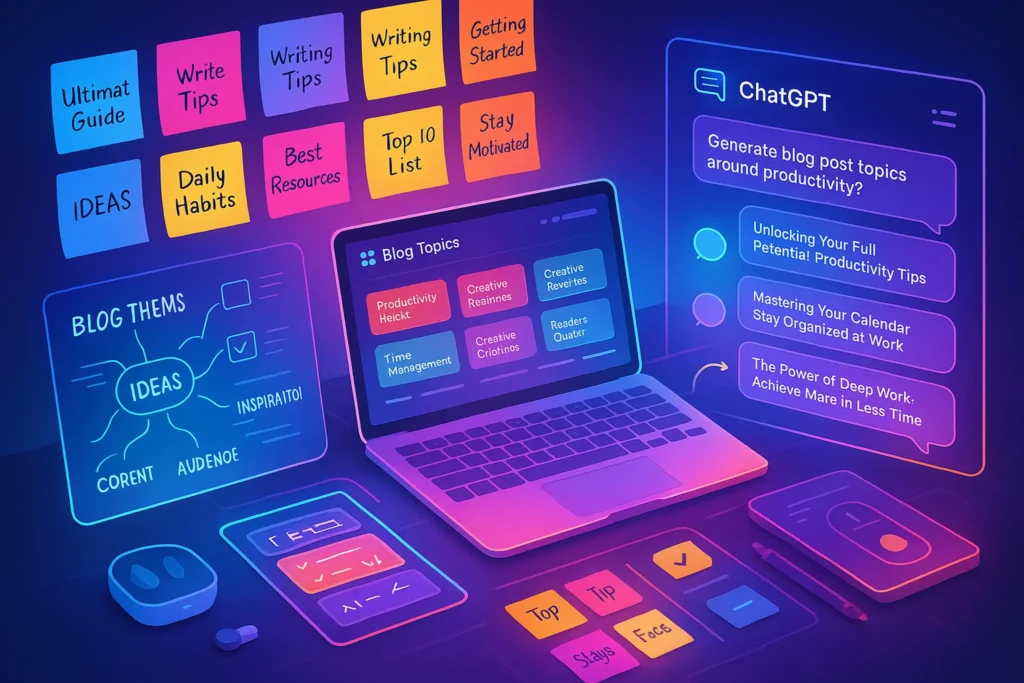-This post may contain affiliate links. If you click on one and make a purchase, I may earn a small commission at no extra cost to you.-
🧠 Why Great Blog Ideas Are the Foundation of Successful Content
Before the headline, before the first draft—every blog post starts with an idea. And in a world where millions of posts are published daily, mediocre ideas get ignored. Great ones get traffic.
So, how do successful creators consistently come up with fresh, relevant, and SEO-smart blog topics?
They don’t rely on inspiration. They use systems.
In this guide, you’ll learn how to:
-
Generate blog ideas based on what your audience actually searches for
-
Use mind mapping to uncover untapped content angles
-
Leverage keyword research and AI to scale ideation
-
Mine your competitors (ethically) for topic gaps
-
Create a personal idea bank that never runs dry
🔍 Still stuck on what to write next?
Our full Keyword Research Guide for ChatGPT teaches you how to turn any niche into 100+ content ideas in minutes. Discover keyword-based brainstorming tactics that actually work 👉 Keyword Research with ChatGPT.
🔹 Start with Your Audience: Their Questions = Your Content
The best blog ideas don’t start with you. They start with your readers’ pain points, curiosities, and goals.
How to tap into their questions:
-
Quora: Search your topic and analyze what people are asking (sort by “Most Viewed”)
-
Reddit: Use subreddits like r/Blogging, r/Marketing, r/YourNiche to spot trending frustrations
-
AnswerThePublic: Visualizes the most searched questions related to a keyword
🧠 A simple habit: every week, jot down 5 real questions your audience asks online. That’s 260 content ideas per year.
When you notice patterns like “how to grow a blog with no traffic” or “blog post ideas for beginners,” those are goldmines waiting to be turned into helpful content.
💡 For a full framework on aligning content with search intent, check out our Ultimate Guide to Using ChatGPT for Keyword Research
🔹 Mind Mapping for Niche Expansion
Once you have a central theme or category, use mind mapping to break it into pillar topics and supporting subtopics.
For example:
Then, for each branch, brainstorm multiple blog titles.
✅ Tools like MindMeister, Miro, or even pen and paper can help visualize idea clusters.
This method ensures your blog doesn’t drift off-topic and helps with internal linking between related articles.
🔄 If you’re repurposing across channels, this approach also fuels email, video, and social formats. See our guide to Repurposing Content.
🔹 Keyword Research as Idea Fuel
Many bloggers think keyword research is just for SEO optimization. But in reality, it’s an idea generation machine.
Use keyword tools to discover:
-
What people already search for
-
How hard it is to rank
-
What competitors are missing
Great tools to try:
-
Ubersuggest: Free option for beginners
-
Ahrefs / SEMrush: Pro tools with advanced filters
-
Google Autocomplete: Type your niche keyword + trigger words (“how to,” “vs,” “best”)
-
ChatGPT: Ask: “Give me 10 blog post ideas on [topic] based on search trends”
This also helps you build blog series that cover a cluster of long-tail keywords, improving topical authority.
✨ Bonus tip: Add selected keywords into a Notion page and tag them by intent (“How-to,” “Product,” “Comparison”) to accelerate drafting.
💡 Also check out: Content Calendar 101 for turning keywords into weekly publishing systems.
🔹 Competitor Mining (Ethically)
Great creators don’t copy—they analyze.
By ethically studying what’s working for others, you can reverse-engineer their content wins and spot gaps they missed.
Where to look:
-
BuzzSumo: See top-shared content in your niche
-
Ahrefs / SEMrush: Discover best-performing keywords + traffic pages of competitors
-
Feedly or RSS Feeds: Track niche blogs and publications for emerging trends
-
Google News: Filter by date to find content gaps or new angles
Example: If your competitor ranks for “Best AI Writing Tools for Bloggers,” you could create a fresh post on “Best AI Writing Tools for Long-Form Bloggers (2025)” with a new twist.
💬 Want inspiration? See our own deep dive: Best AI Writing Tools for Bloggers
🔹 AI-Based Idea Generation
AI tools are not just for writing—they’re excellent brainstorming partners too. When you train them with context and clear prompts, they generate topic angles you might never consider.
Tools to explore:
-
ChatGPT (with prompt tuning): Try prompts like:
“Give me 15 evergreen blog ideas for beginner fitness bloggers focused on monetization.”
-
Jasper’s Blog Topic Generator: Fast suggestions with tone and audience targeting
-
Copy.ai: Plug in a niche, get dozens of content titles
-
HubSpot Blog Idea Generator: Great for quick creative input
These tools especially shine when you want volume + variation, or when you’re tackling writer’s block.
🧠 Stuck on a niche? Here’s a helpful read: How to Beat Writer’s Block
🔹 Creating an Idea Bank for Long-Term Blogging
All the ideas in the world don’t help if you forget them. That’s why a structured idea bank is your most underrated blogging asset.
How to set up your idea vault:
-
Use Notion, Trello, or even Google Sheets
-
Categorize by:
-
Topic
-
Target Keyword
-
Intent (How-to, Review, Comparison, etc.)
-
Priority
-
Status (Planned, Drafting, Published)
-
Every time an idea hits you (on a walk, during a call, browsing YouTube), dump it here. Creativity happens in bursts—capture them.
📅 Want to combine this with a publishing workflow? Read: Content Calendar 101
📊 Idea Generation Tools Table
| Tool | Purpose | Pricing |
|---|---|---|
| AnswerThePublic | Find audience questions | Freemium |
| ChatGPT | Smart prompt-based ideation | Free / Plus |
| Ubersuggest | Keyword ideas + SEO difficulty | Freemium |
| MindMeister | Visual mind mapping | Freemium |
| Jasper / Copy.ai | AI blog title generators | Paid |
| BuzzSumo | Find top-shared content | Paid |
| Feedly | Track content trends | Free / Pro |
✅ Action Checklist: Build Your Idea Engine
Use this as a repeatable system to stay ahead of the content curve.
-
Identify top 3 pain points your audience faces
-
Use Quora + Reddit to spot trending questions
-
Create a mind map for one pillar topic
-
Do keyword research on 5 subtopics
-
Analyze 2 competitors’ blogs via BuzzSumo or Ahrefs
-
Generate 10 new titles using ChatGPT
-
Add them to your Notion or Trello idea bank
-
Review weekly and label “Ready to Write” titles
📊 The ICE Method: Prioritize Your Best Blog Ideas
Brainstorming is just the start. Once you have dozens of ideas, the next challenge is: which ones should you write first?
Use the ICE Method to rank and prioritize:
| Factor | Description | Score (1–10) |
|---|---|---|
| Impact | How valuable is this topic to your target audience? | 1–10 |
| Confidence | How confident are you in covering this topic well? | 1–10 |
| Ease | How easy is it for you to create this content today? | 1–10 |
Total Score = Impact × Confidence × Ease
Example:
“How to Start a Blog in 2025” → 9 × 9 × 7 = 567
“Top 5 CMS Platforms for Large Enterprises” → 4 × 6 × 4 = 96
The higher the ICE score, the sooner you should move it into your content calendar.
✅ This ensures you don’t just collect ideas—you execute the right ones first.
💬 AI Prompt Bank: Ready-to-Use for Blog Ideation
Use these tested prompts inside ChatGPT, Jasper, or Copy.ai to spark dozens of tailored blog titles:
Prompt 1:
Give me 15 evergreen blog post ideas for a beginner travel blogger who wants to monetize with affiliate links.
Prompt 2:
Suggest 10 SEO-optimized blog titles for a tech site focused on AI productivity tools in 2025.
Prompt 3:
Brainstorm blog ideas for a parenting blog targeting working moms in the US.
You can even stack prompts like:
“Turn each into a how-to title + suggest potential subheadings.”
These aren’t just titles—they’re seeds for full content outlines.
🔍 Mini Case Study: How 120 Blog Ideas Were Born in 1 Weekend
“The Blog Vault That Changed Everything”
Sarah, a freelance tech blogger, struggled with content consistency. She’d brainstorm once a week—then freeze.
She took a new approach:
-
Mapped her main categories in MindMeister
-
Used ChatGPT to generate 10 titles per subtopic
-
Added all ideas to Notion with ICE scoring
By Sunday night, she had 120+ structured blog ideas, each labeled by topic, keyword, and priority.
Now? She opens Notion, picks the next title, and writes. No friction. No blank page. Just flow.
🌊 Blue Ocean Blogging: Don’t Just Echo the Internet
One of the biggest traps in idea generation is chasing what everyone else is writing. Yes—look at competitors. Yes—use keywords. But also ask:
“What isn’t being said yet?”
“What unique spin can I bring?”
“What intersections haven’t been explored?”
Combining two niche angles (e.g., “AI Tools” + “Blogging for Seniors”) or revisiting an old topic with 2025 data often leads to blue ocean content—topics with high value, low competition.
🧠 Be the first to publish that twist. That’s where authority is built.
🧠 Nerd Verdict
Consistent blogging doesn’t require constant inspiration—it requires a repeatable idea generation engine. The creators who never run out of content aren’t more creative. They’re more organized, curious, and methodical.
Start with your audience. Map your niche. Let tools and AI support the process—but own the strategy.
Because at the end of the day, your next great blog post is only as strong as the idea it’s built on.
❓ FAQ: Nerds Ask, We Answer
💬 Would You Bite?
How do you come up with blog ideas consistently?
Are you more of a mind-mapper or an SEO researcher—or do you let ChatGPT lead the way?Drop your method (or struggle) in the comments 👇



